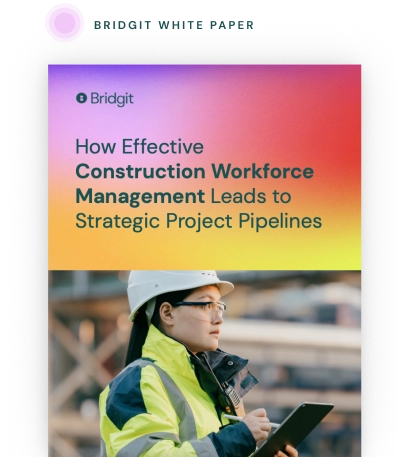A construction look-ahead schedule can be a valuable resource. The construction industry is constantly challenged to do more with less with a reduced workforce. Recognizing when it’s time to take on new projects (or when it’s time to expand your team) is paramount for thriving in an increasingly competitive industry.
Table of Contents
With most companies opting to use spreadsheets and whiteboards to manage their workforce, it’s no wonder why so many operations teams struggle to identify gaps where a new project can fit into their workforce plan. Predicting how busy your team will be with a two-week look ahead construction schedule is extremely difficult to do out of a spreadsheet—and just as difficult with a whiteboard.
Taking on projects when your team is already spread thin can lead to projects falling behind schedule, inevitably ending with teams feeling overworked, resulting in lost money. Adversely, not knowing when your company is available to take on more projects can lead to hesitating on achievable bids and underutilizing your team—again, resulting in money lost.
Using data to forecast and better plan your workforce
Being able to accurately peer into the future of your construction resource management in relation to projects will allow you to set your teams up for success and ensure you’re getting the most out of your workforce. To successfully look ahead at your construction resource management with a construction look ahead schedule, you will need to be able to identify the following key pieces of data:
- The amount of work being performed on a team and individual basis
- Periods when the company has taken on more work than there are workers
- Periods when the company has team members that are being under-utilized and need more work
Want to take it one step further? Recognize opportunities for qualified team members to step up and take on a new project role. This will keep them engaged with meaningful work while also showing a path and opportunity for career growth.
This is also where construction look-ahead schedules come in, allowing you to more effectively coordinate work from a few weeks to a few months ahead.

Use your workforce data to create a competitive advantage
Download our white paper to see how effective workforce planning can help stay ahead of labor demands and create a strategic project pipeline.
What are construction look-ahead schedules?
Construction look-ahead schedules help construction managers and project coordinators plan the sequence of tasks that must be completed to finish a construction project on time. Projects can be more effectively kept on track by looking at the big picture and identifying potential bottlenecks.
One of the most important aspects of creating a look-ahead schedule is accuracy. All too often, construction projects fall behind because the initial task list is not accurate. When creating a look ahead schedule, it’s important to consult with all construction team members, including subcontractors, to get a realistic estimate of how long each task will take.
In addition to accuracy, another key element of successful look-ahead scheduling is flexibility. Construction projects are often subject to unexpected delays, so building flexibility into the schedule is important. For example, rather than scheduling a particular trade to work for two weeks straight on one task, it may be more effective to schedule them for two days per week over the course of four weeks. The project will not fall behind schedule if there are any delays with other trades or the materials needed for the task.
Creating an effective construction look-ahead schedule requires careful planning and coordination. However, by creating a realistic and flexible schedule, construction managers can help ensure their projects stay on track.
What is included in a construction look ahead schedule?
Construction look-ahead schedules are one of the most important tools a project manager has at their disposal, so it’s vital to create and maintain a comprehensive and accurate one to ensure that the project goes as planned and make all stakeholders aware of upcoming deadlines and milestones.
There are a few key elements that should be included in any construction look-ahead schedule template, including the following:
- Major milestones and construction phases
- Which contractors or subcontractors are responsible for each task associated with each milestone
- An estimated time frame for completion of each task
Whether it’s a two-week look ahead construction schedule template or one that plans for months ahead, this information should always be included.
With each change, the schedule should also be regularly updated and distributed to all project stakeholders.
Types of construction look ahead schedules
Here are templates for the types of schedules that are usually utilized in construction projects.
Look-ahead template for equipment & material forecasting
For equipment and material forecasting, consider creating your schedule with these specific elements:
- Project name
- Contract number
- Date of time span
- Work task description
- Start date
- End date
- Equipment/materials involved
- Amount of equipment and materials available, planned by day, Monday through Friday
Look ahead template for labor forecasting
For labor forecasting, consider creating your schedule with these specific elements:
- Project name
- Contract number
- Date of time span
- Work task description
- Start date
- End date
- Resource (worker) name associated with the task
- Amount of labor available, planned by day, Monday through Friday
How Bridgit Bench leverages data for proper planning
Keeping track of these data points with a construction look-ahead schedule will help improve your workforce’s efficiency and utilization over the long term. It can help with:
- Retaining an experienced workforce
- Adjusting the flow of new hires to meet company needs
- Hiring more capable and experienced workers by offering them more stable employment than your competition
With this information, construction companies can confidently invest in new projects, knowing they have the available workforce to deliver the project on time and within budget.
This is one of the many ways Bridgit Bench can positively impact your construction resource management and planning. Bridgit Bench users regularly express how much being able to look ahead at their workforce plan has helped them when making new bids.
For more information about resource scheduling, check out our guide to construction resource scheduling.
When considering two-week look ahead construction schedules, you may be wondering how Bridgit Bench helps. Let’s reflect on the data points we referred to earlier, including:
- The amount of work being performed on a team and individual basis
- Periods when the company has taken on more work than there are workers
- Periods when the company has team members that are being under-utilized and need more work
Bridgit Bench is the leading construction workforce management software providing accurate insight into how much work your employees are doing. It provides you with one simple visual that lets you see exactly what percentage your team members have been allocated at any given time and anyone that may be over or under-allocated.
Construction Estimating Software FAQ
What is digital construction estimating software?
Construction estimating software is used by estimating teams to calculate and predict costs for a construction project. These digital tools help streamline the estimation process from bid creation to cost analysis to ensure proposals are as precise as possible and help put forward successful bids. Getting estimates right up front is a key part of managing project scope creep in construction.
How does construction estimating software work?
Construction estimating software works by allowing users to input project details and then use built-in databases to forecast expenses. Advanced estimating software may use algorithms and machine learning to help forecast expenses. It’s important that when you evaluate your construction estimating software, you consider how it integrates with your process. You will want to pull in data from tools, like your CRM and workforce planning software, as well as information from project documents.
What is estimating in construction?
Estimating in construction involves calculating the costs for a project including items like materials, wages, equipment, and real-estate costs. Forecasting line-by-line expenses accurately is key to creating successful bids that win contracts and also ensuring your project is profitable. Estimating is an important skill in construction, as it’s a balance act between what you think will happen and what will happen.
This clear visual helps construction companies look six months to 3 years ahead and identify gaps in their workforce plan that indicate where a new project can be undertaken. It also allows you to identify trends in your workforce utilization—if you see lots of green, you may want to pick up another project. Seeing too much orange means you might be spreading your team too thin.
You can search for an individual directly or any field associated with a person in the search bar or apply filters like title and next availability to isolate specific groups you want to focus on. The People List is synced with your People Gantt, meaning you can search, sort, and filter from the People List and have those settings carry over to your People Gantt and vice versa.
We also mentioned that along with construction look ahead schedules helping with planning, recognizing opportunities for growth within your staff will help keep them more engaged in their work and excited for upcoming projects that provide meaningful work and experience. You can access an individual’s profile directly from the People Gantt in Bridgit Bench.
This allows you to check in on any number of people’s details, including custom fields you’ll be encouraged to add. Details like “certifications” and “willingness to relocate” provide valuable insight when offering someone professional growth opportunities.
Bridgit Bench is the #1 construction resource management tool for a reason. We take every aspect of your workforce plan as seriously as you do—from understanding the importance of effective manpower meetings to having the ability to look ahead at your company timeline to make realistic changes to your workforce plan to align with company strategy.


